This article delves into the effective implementation of Account-Based Marketing (ABM) through HubSpot, underscoring the critical need to target high-value accounts while synchronizing marketing efforts with sales teams. By defining ideal customer profiles and creating personalized content, businesses can significantly enhance their marketing strategies. Leveraging HubSpot's integrated tools is essential for streamlining these efforts. Furthermore, continuously measuring campaign performance allows for the optimization of strategies, ultimately leading to improved engagement and return on investment (ROI).
To tackle the challenges of ABM, organizations must first identify their ideal customer profiles. This foundational step not only clarifies the target audience but also informs the creation of tailored content that resonates with potential clients. In addition, utilizing HubSpot's robust features facilitates a seamless connection between marketing and sales teams, ensuring that both departments work towards common goals.
As you implement these strategies, it is crucial to measure the performance of your campaigns consistently. This ongoing assessment enables you to refine your approach, maximizing engagement and ROI. By adopting a proactive mindset and leveraging data-driven insights, businesses can navigate the complexities of ABM with confidence and authority.
Introduction
In the rapidly evolving landscape of B2B marketing, Account-Based Marketing (ABM) has emerged as a pivotal strategy for organizations seeking to maximize their impact. By concentrating on high-value accounts instead of casting a wide net, businesses can develop personalized campaigns that resonate deeply with their target audience. This focused approach not only fosters stronger collaboration between sales and marketing teams but also results in remarkable improvements in revenue and customer engagement.
As companies increasingly recognize the efficacy of ABM, the integration of robust platforms like HubSpot becomes essential for streamlining efforts and enhancing results. This article explores the significance of ABM, outlines the advantages of utilizing HubSpot, and provides practical steps for implementing successful campaigns that drive sustainable growth in 2025 and beyond.
Understanding Account-Based Marketing: Definition and Importance
Account-Based Marketing represents a focused approach that prioritizes high-value accounts over a broad audience, fostering a collaborative environment between marketing and sales teams. This alignment is crucial; B2B organizations with synchronized sales and marketing operations experience revenue growth that is 24% faster and profits that are 27% higher over a three-year period. The significance of account-based marketing in 2025 is underscored by its capacity to create personalized promotional campaigns tailored to the unique needs of each account, resulting in increased conversion rates and enhanced return on investment (ROI).
To maximize the effectiveness of ABM, integrating solutions with Buldok Marketing's comprehensive 360° services can streamline customer journeys and enhance business performance. The modular system empowers businesses to customize their approach, utilizing tools like the Marketing Hub to manage online marketing from a single platform, generating qualified leads and engaging the right audience. The Sales Hub standardizes the sales process, equipping teams with modern tools to close deals more efficiently, while the Service Hub ensures exceptional customer service, transforming clients into enthusiastic promoters of your brand.
Buldok Marketing's 360° services complement these HubSpot solutions by offering customized approaches and support that enhance the execution of account-based marketing initiatives.
Recent trends indicate a growing adoption of ABM approaches, with 76% of companies expanding their programs in 2021, up from 58% in 2020. This shift reflects a broader recognition of ABM's effectiveness; companies utilizing these strategies report a remarkable 90% engagement rate with targeted accounts and a 50% improvement in customer re-engagement through personalized messaging. Furthermore, 85% of marketers have noted enhanced customer retention as a direct result of implementing ABM.
The importance of ABM is further highlighted by the current landscape, where only 20% of marketers feel equipped with the in-house expertise to manage ABM programs. However, there is optimism, with 38% believing that advancements in artificial intelligence will reduce costs and simplify the management of these programs. As Danilo Nikolich, Sr. Director of SDRs at RollWorks, aptly states, 'ABM is about the overlap, not the handoff,' emphasizing the necessity for marketing teams to provide strategic support as sales teams engage with targeted accounts.
In summary, this tailored approach not only boosts engagement but also nurtures stronger relationships with key stakeholders, making it an essential element of contemporary promotional methods in 2025.
Why HubSpot is the Ideal Platform for Account-Based Marketing
HubSpot emerges as a premier choice for account-based marketing, offering a robust suite of tools that seamlessly integrate marketing and sales. Buldok Marketing can leverage its Customer Relationship Management (CRM) system, combined with targeted email campaigns and advanced analytics, to empower businesses in crafting personalized experiences tailored to each account. This level of personalization is crucial, particularly as B2B sectors increasingly adopt ABM strategies, with a significant shift towards B2C applications driven by the preferences of Millennial and Generation Z buyers.
The platform's capability to monitor engagement and interactions across various channels provides a comprehensive view of account activity, enabling marketing teams to refine their strategies effectively. The CRM system allows users to manage all contact data and previous interactions, enhancing communication through integrated solutions such as phone, email, live chat, Messenger, and WhatsApp. This degree of personalization and interaction is essential for optimizing customer involvement and satisfaction.
For instance, the incorporation of artificial intelligence (AI) within the platform's framework has been shown to increase revenue for 79% of enterprises, underscoring its role in enhancing ABM efficiency. Furthermore, the platform's automation capabilities simplify processes, allowing teams to concentrate on strategic initiatives rather than being bogged down by manual tasks. The Service Hub complements this by providing full-service customer support, transforming customers into enthusiastic promoters of your business.
In 2025, the State of Marketing report highlights that AI-powered workflows and value-driven campaigns are at the forefront of successful marketing strategies. As companies allocate more resources to ABM—budgets have reportedly increased by 59%, with 20% of firms experiencing significant budget allocation increases—the necessity for a platform that can adapt and scale with these changes becomes paramount. This platform not only meets this demand but excels in providing the essential tools for businesses to leverage ABM effectively, ensuring they remain competitive in an evolving marketplace.
The benefits of utilizing this solution for ABM are manifold: from shortening sales cycles to enhancing team performance, its capabilities are designed to improve operational efficiency and customer satisfaction. As businesses continue to embrace ABM, Buldok Marketing recognizes the platform as the optimal choice for those seeking to maximize their return on investment in 2025 and beyond. Additionally, the bar chart data indicates that top content formats delivering ROI in 2025 range from 11 to 21, further emphasizing the effectiveness of the platform's tools in driving successful ABM strategies.
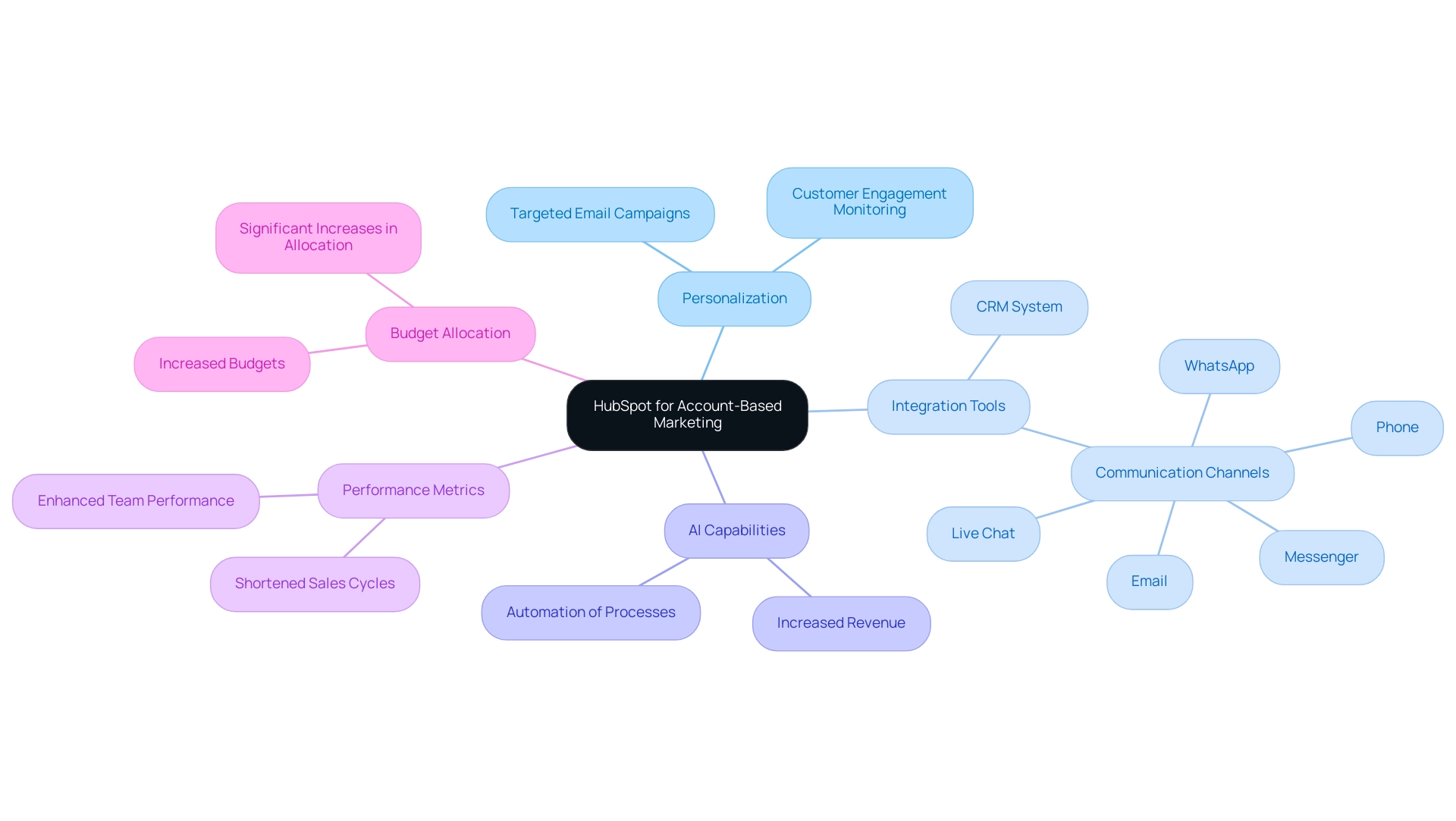
Setting Up Your ABM Campaign in HubSpot: A Step-by-Step Approach
To effectively establish your Account-Based Marketing (ABM) campaign within the platform, follow this structured approach:
-
Define Your Ideal Customer Profile (ICP): Start by pinpointing the essential characteristics of your target accounts. This includes factors such as industry, company size, and revenue, which will enable you to concentrate your efforts on the most promising prospects.
-
Create Target Account Lists: Leverage the list segmentation feature to assemble a comprehensive list of accounts that align with your ICP. This targeted strategy, recognized as account-based marketing in HubSpot, ensures that your marketing endeavors are directed toward the right audience.
-
Activate ABM Tools: Access the ABM features by navigating to CRM > Companies in the platform and selecting 'See Target Accounts.' This crucial step allows you to utilize the full capabilities of the account-based marketing functionalities in HubSpot, which are further enhanced by the integration of the Operations Hub for seamless data management across your tech stack. The Operations Hub facilitates automatic synchronization, cleaning, and management of data across all tools and applications in your company, ensuring that your ABM efforts are backed by accurate and up-to-date information.
-
Develop Personalized Content: Create tailored promotional materials that specifically address the unique needs and pain points of each target account. Customized content significantly enhances engagement and demonstrates your awareness of their challenges, supported by the CRM's capability to efficiently organize contact details and previous interactions.
-
Launch Your Campaign: Utilize the email marketing and social media tools to connect with your target accounts through personalized messaging. This multi-channel approach maximizes your chances of capturing attention and generating interest, while integrated communication solutions enable immediate engagement across various platforms.
-
Monitor and Adjust: Employ analytics tools to track engagement metrics and assess the effectiveness of your campaign. Continuous monitoring allows you to implement data-driven modifications to your approach, ensuring optimal results. The Operations Hub will assist in synchronizing and overseeing your data, enhancing your ability to respond to insights swiftly.
By adhering to these steps and leveraging Buldok Marketing's comprehensive integration of solutions, you can cultivate a successful account-based marketing strategy in HubSpot that generates measurable outcomes and fosters enduring client relationships.
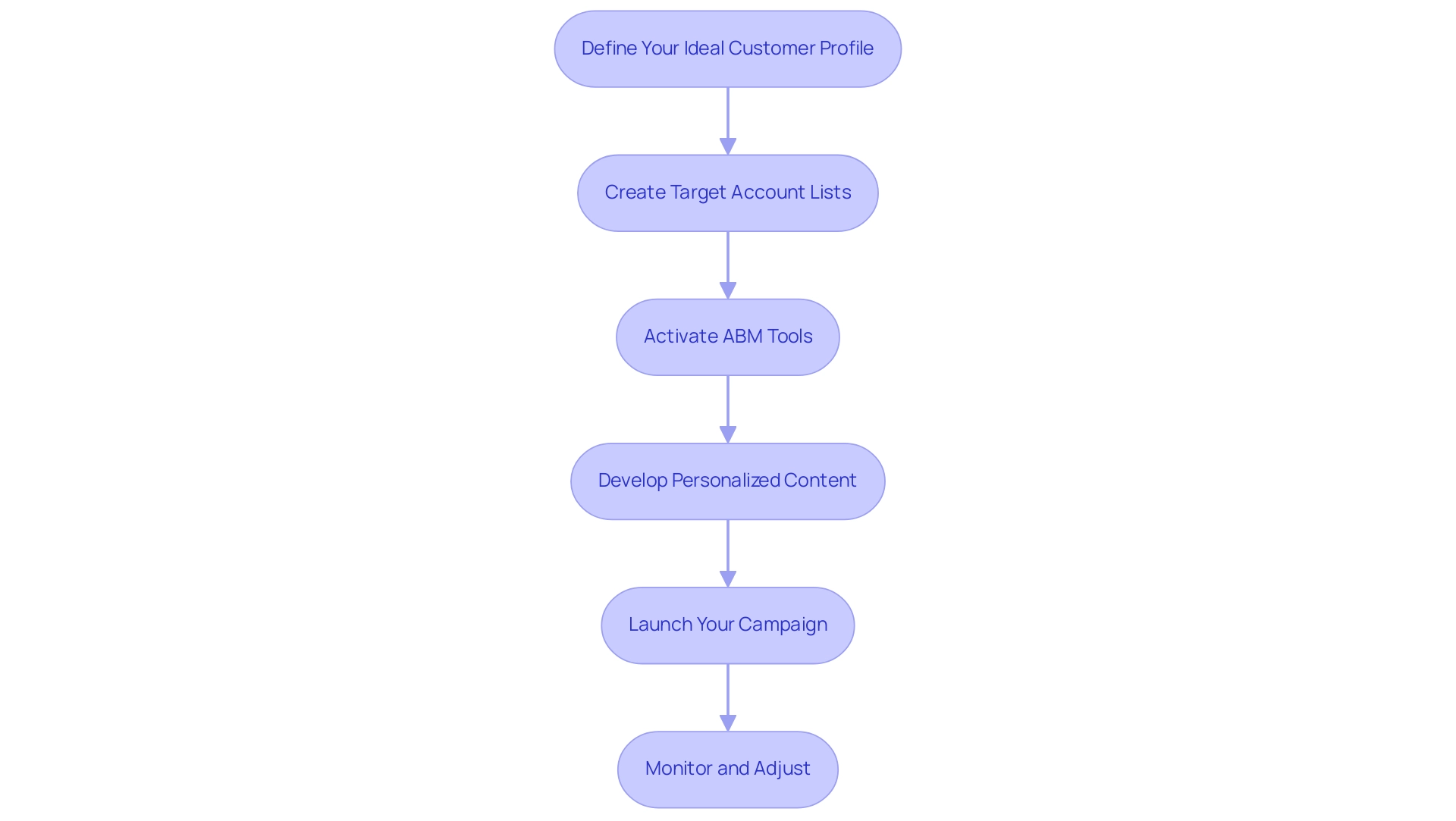
Creating Targeted Lists for Effective ABM in HubSpot
Creating targeted lists in the HubSpot platform is essential for the success of your Account-Based Marketing (ABM) strategy. With Buldok Marketing's Naplno service, you can unlock the full potential of the Operations Hub, regardless of your experience level. Here’s a step-by-step guide to help you effectively segment your audience:
- Access the Lists Tool: Begin by logging into your HubSpot account, navigating to 'Contacts', and selecting 'Lists'.
- Create a New List: Click on 'Create List' and choose between an active or static list based on your campaign requirements.
- Define Criteria: Utilize filters to establish criteria for your target accounts, focusing on key factors such as industry, location, and company size. This targeted approach is crucial; companies that align their marketing and sales efforts experience a 67% increase in deal closure effectiveness and a 36% increase in customer retention rates.
- Segment Your Audience: Further refine your list by segmenting based on engagement levels or specific interests. Personalization can significantly enhance your account-based marketing HubSpot efforts, as 49% of marketers prioritize growth within existing accounts. A satisfied client of Buldok Marketing remarked, "The insights and tactics provided by Buldok Marketing have transformed our approach to account-based marketing HubSpot, resulting in measurable improvements in our engagement and conversion rates."
- Save and Name Your List: After defining your criteria, save the list and assign a descriptive name for easy reference in future campaigns.
- Utilize the List in Campaigns: Implement this targeted list in your ABM campaigns to ensure your messaging resonates with the right audience, ultimately driving higher engagement and conversion rates.
By following these steps, you can leverage the platform’s capabilities, enhanced by Buldok Marketing's consulting services, to create effective targeted lists that elevate your account-based marketing HubSpot strategy. This leads to improved customer retention and increased sales effectiveness. Notably, the growth of ABM programs from 58% in 2020 to 76% in 2021 underscores the increasing significance of these approaches, as illustrated in the case study 'Alignment Leads to More Deals and Higher Retention Rates.
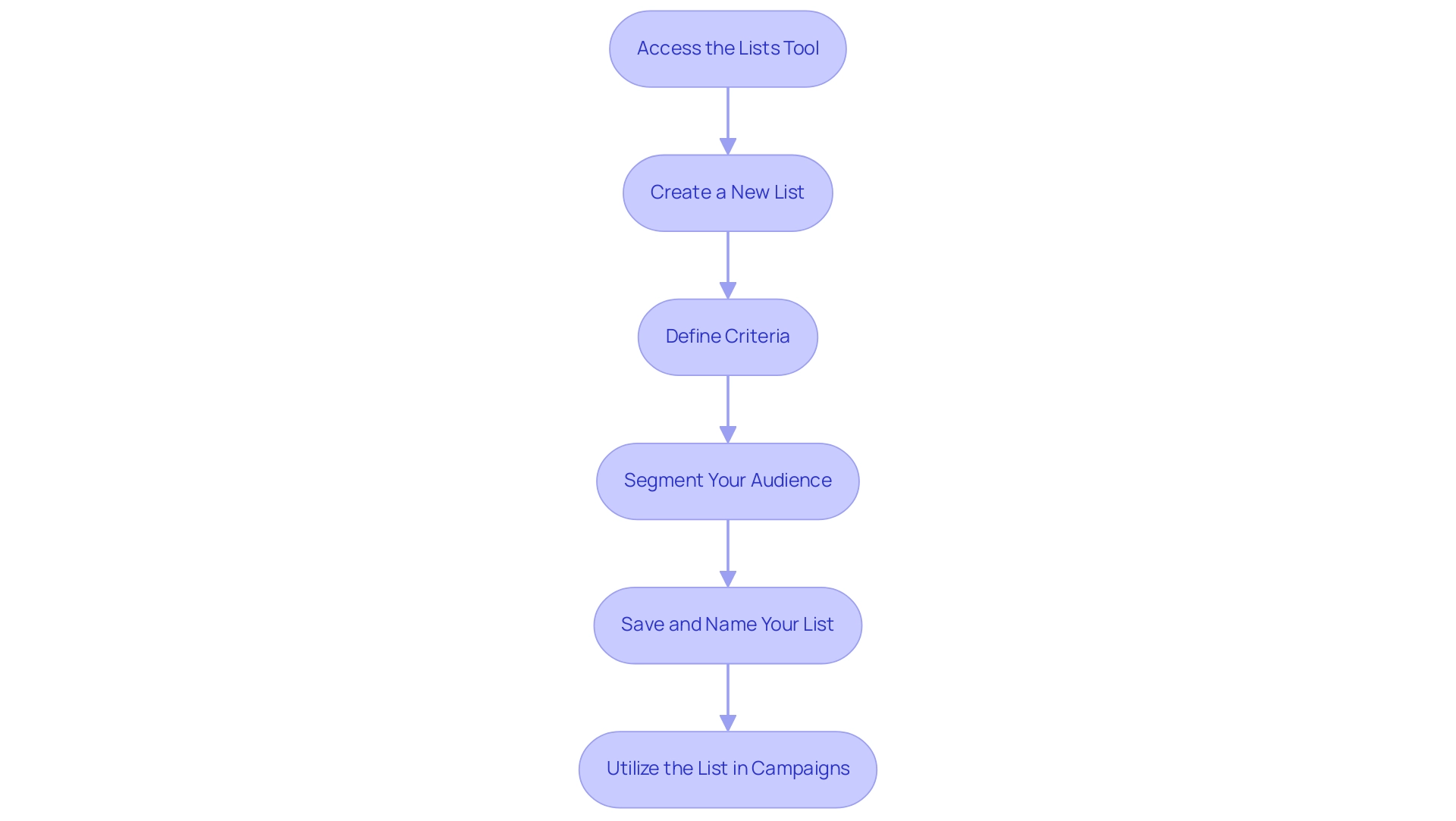
Leveraging HubSpot's Features for Personalized Marketing Efforts
To effectively leverage the platform's features for tailored promotional initiatives and optimize your ROI, consider implementing the following strategies with the comprehensive support of Buldok Marketing:
-
Use Dynamic Content: Integrate dynamic content into your emails and landing pages to customize messaging according to the recipient's profile and behavior. This approach not only enhances relevance but also fosters a deeper connection with your audience, aligning with Buldok Marketing's objective of streamlining customer journeys.
-
Segment Your Lists: Regularly update and segment your lists based on engagement metrics and interactions. The State of Marketing Report indicates that segmented emails generate 30% more opens and 50% more click-throughs compared to their unsegmented counterparts. This practice ensures your messaging remains pertinent and resonates with your audience's specific interests, ultimately driving higher engagement rates and enhancing business performance.
-
Utilize Smart CTAs: Develop smart calls-to-action that adapt based on the viewer's characteristics. By customizing these CTAs, you can significantly boost conversion rates, as they cater to the needs and preferences of each individual, maximizing your promotional efficiency with the Marketing Hub.
-
Track Engagement: Leverage HubSpot's robust account-based marketing tools to monitor how target accounts engage with your content. This data enables real-time adjustments to your strategy, ensuring your promotional efforts consistently align with audience behavior. Marketers face increasing challenges from the integration of AI tools into their workflows, underscoring the necessity for experimentation with AI applications to enhance personalized promotional efforts.
-
Personalize Follow-Ups: After initial outreach, tailor your follow-up communications based on the responses and engagement levels of each account. Personalized follow-ups can strengthen relationships and improve conversion chances, as they demonstrate attentiveness to the recipient's needs. However, be cautious of consumer perceptions; many view certain personalized promotional tactics as 'creepy,' making careful personalization essential.
By employing these methods, businesses can maximize the effectiveness of their personalized initiatives, ultimately leading to improved engagement and higher ROI. Furthermore, consider utilizing the modular system, which includes the Marketing Hub, Sales Hub, and CRM functionalities, to further enhance your promotional activities. The growing significance of digital marketing platforms is underscored by TikTok's advertising revenue, which reached $4 billion in 2022 and is projected to double by 2024, emphasizing the need for marketers to adapt their strategies accordingly.
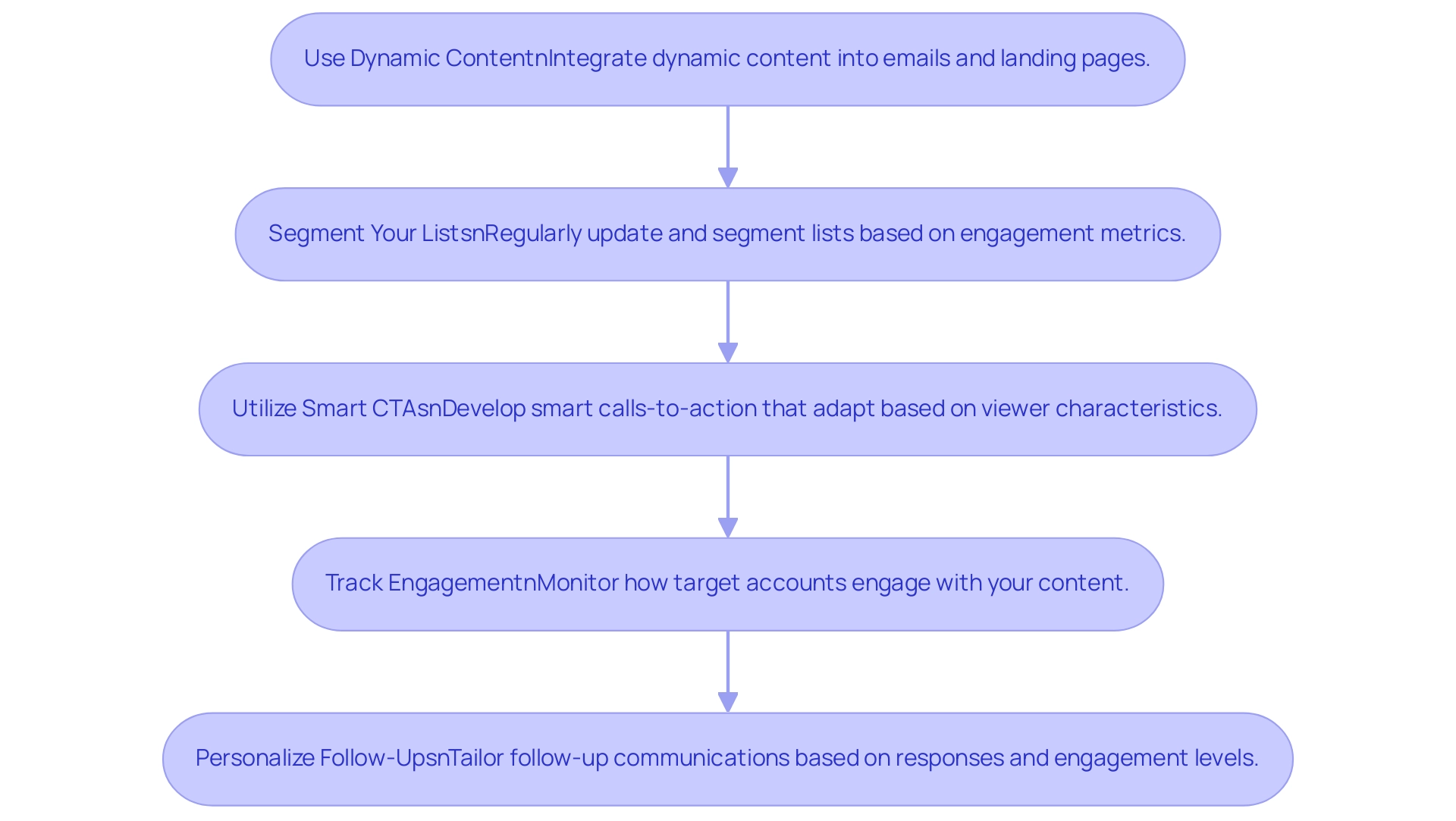
Measuring the Success of Your ABM Campaigns in HubSpot
To effectively measure the success of your Account-Based Marketing (ABM) campaigns in HubSpot, a structured approach is essential.
-
Establish Clear KPIs: Start by defining key performance indicators (KPIs) that align with your business objectives. Focus on metrics such as engagement rates, conversion rates, and revenue generated from your target accounts. These KPIs will serve as benchmarks for evaluating your campaign's effectiveness.
-
Leverage Account-Based Marketing HubSpot: Utilize HubSpot's robust reporting capabilities to create custom dashboards tailored to your defined KPIs in your marketing strategy. This enables you to visualize performance data and track progress in real-time, ensuring you remain informed about your campaign's impact.
-
Monitor Engagement Metrics: Keep a close eye on engagement metrics, including email open rates, click-through rates, and website visits from your target accounts. These indicators will help you assess the level of interest and interaction your campaigns are generating.
-
Evaluate Pipeline Progression: Analyze how target accounts navigate through the sales funnel. By tracking their progression, you can identify any bottlenecks or areas where potential leads may be dropping off, allowing for timely interventions.
-
Refine Approaches Based on Insights: Use the insights gathered from your analysis to adjust your ABM approaches. Concentrate on enhancing the strategies that yield the best outcomes for your target accounts, ensuring that your efforts are both efficient and effective.
In 2025, ABM campaigns are anticipated to enhance conversion rates by as much as 40%, underscoring the significance of accurate measurement and refinement of plans. Key performance indicators for ABM can be categorized into three main groups: market reach and engagement, pipeline and conversion metrics, and account retention and growth. This comprehensive method of measuring success will enhance your promotional efforts and drive sustainable growth.
Moreover, incorporating the Service Hub into your strategy can significantly enhance customer engagement. As the only software designed for comprehensive customer service, it enables businesses to transform clients into enthusiastic promoters. Buldok Marketing's holistic integration of CRM solutions not only streamlines marketing and sales processes but also ensures that customer support aligns with your account-based marketing HubSpot initiatives.
Specific features of HubSpot Service Hub, such as ticketing systems and customer feedback tools, can further enhance your ability to engage with clients effectively.
As Reena Misra, ANZ Marketing Leader, states, "When I think ABM, I think xGrowth. Growth were 100% committed, the whole team was just like our business partner. I would say you are not a business vendor; you are our business partner." This highlights the importance of collaboration in ABM approaches.
Additionally, consider the case study of Vikas Bhatt and ONLY B2B, which illustrates how targeted B2B promotional campaigns can effectively connect businesses with the right audience in a competitive market. ONLY B2B specializes in demand generation, content syndication, and database services, providing a unique approach to lead generation that has benefited clients across various industries globally. Incorporating these elements into your ABM approach will enhance its relevance and applicability.
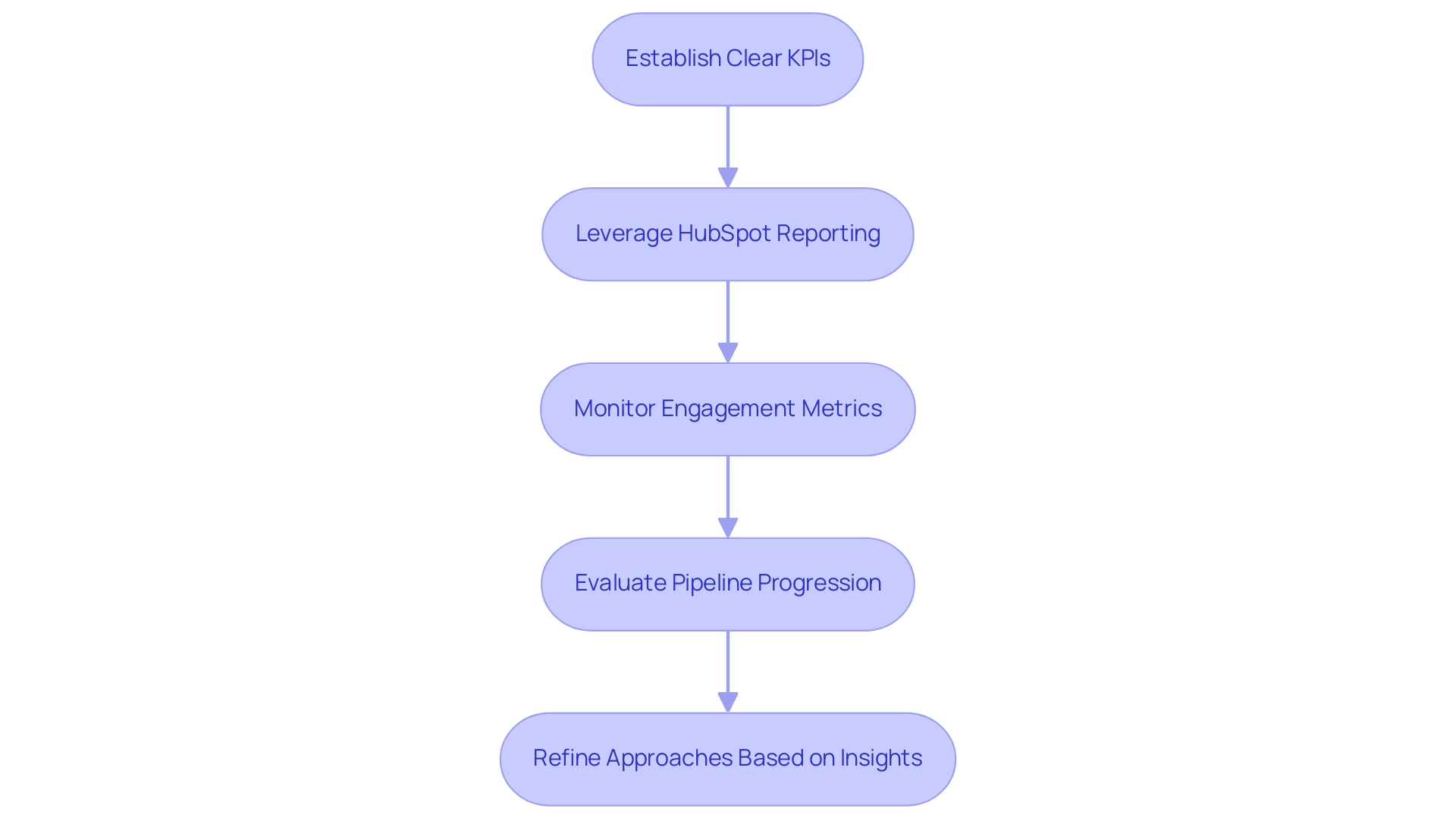
Integrating HubSpot with Other ABM Tools and Technologies
Integrating HubSpot into your account-based marketing strategy with other ABM tools can significantly elevate your marketing efforts. Begin by identifying key tools that will support your ABM approach. This may include CRM systems, data enrichment tools, and analytics platforms that align with your business objectives. Notably, almost 70% of marketers plan to increase spending on intent data next year, underscoring the growing importance of data in ABM strategies.
Furthermore, utilize the App Marketplace to discover integrations that can streamline your workflows and enhance data sharing. This resource provides a range of tools created to function smoothly with the platform, ensuring a unified promotional ecosystem.
In addition, establishing data syncing between your CRM and other tools is crucial. This ensures that information remains accurate and up-to-date, which is vital for effective decision-making and personalized customer experiences. Notably, only 36% of companies executing ABM report tight alignment between their sales and marketing teams, highlighting the need for improved data integration.
For businesses with unique requirements, leveraging API integrations offers the flexibility to create custom integrations tailored to specific needs. This capability allows for deeper connections between the system and other platforms, enhancing the overall effectiveness of your ABM initiatives. With Service Hub, you can ensure comprehensive customer service, while the CMS Hub allows for flexible website management that supports your growth objectives. The modular nature of HubSpot enables you to customize your approach based on your specific business needs.
Finally, regularly monitoring the performance of your integrations is essential to ensure they are delivering the anticipated benefits. Adjustments may be necessary to optimize functionality and improve campaign outcomes. Companies that have implemented ABM strategies have reported an 84% improvement in reputation and an 80% enhancement in customer relationships, underscoring the importance of effective integration. As Danilo Nikolich, Sr. Director of SDRs at RollWorks, states, "ABM is about the overlap, not the handoff. Think about it this way: A successful ABM approach enables your marketing team to provide air cover and targeted programs as you, the sales team, are going outbound to target accounts."
By following these steps and leveraging the full potential of the platform, including the Service Hub and CMS Hub, you can enhance your efforts in account-based marketing with Buldok Marketing, ultimately driving better engagement and results for your business.
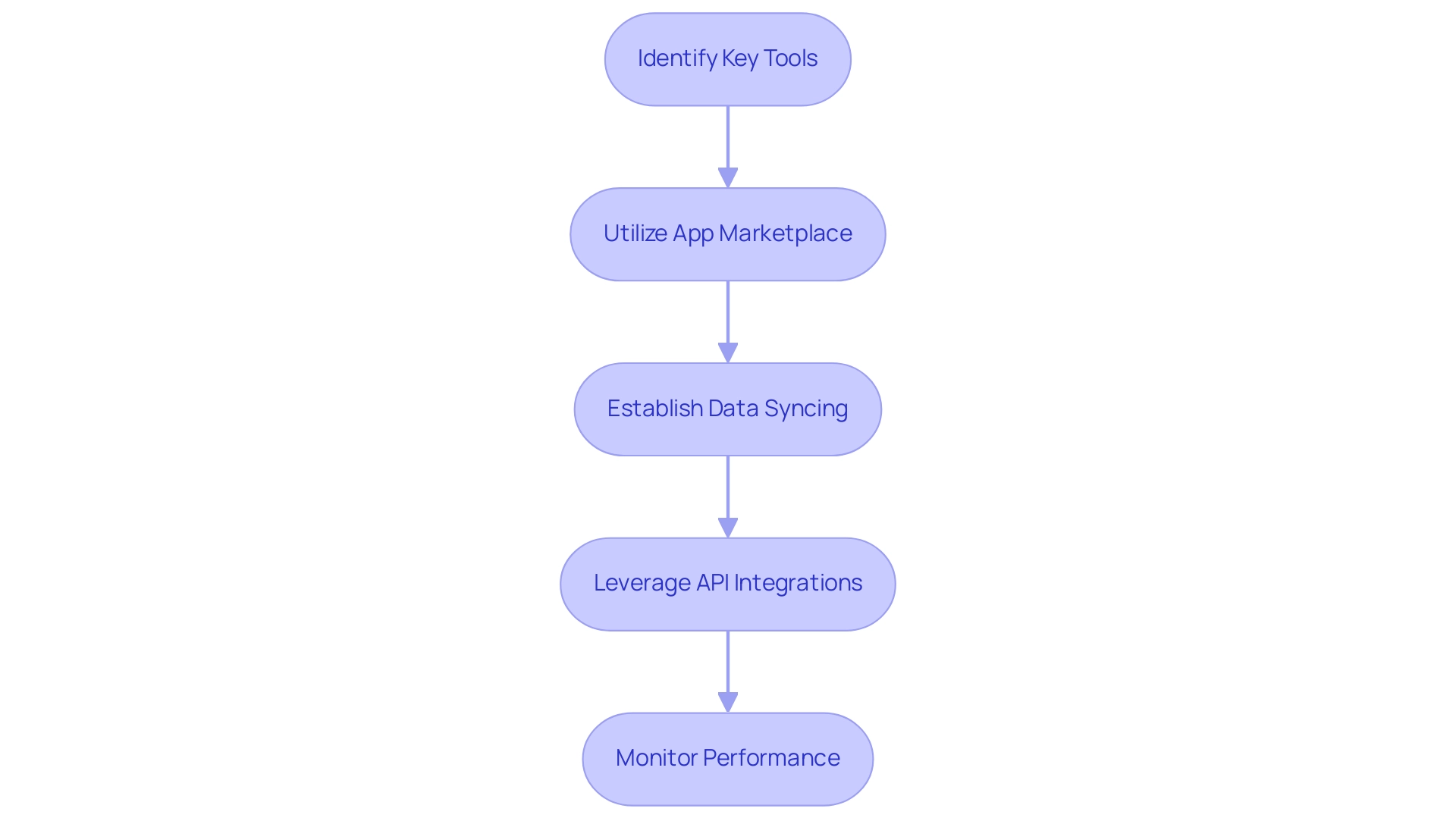
Advanced Tips for Maximizing HubSpot's ABM Features
To fully leverage HubSpot's Account-Based Marketing (ABM) features, consider implementing the following advanced strategies:
-
Leverage AI-Powered Insights: Utilize the advanced AI capabilities of the platform to analyze account behavior and preferences. This allows for the creation of highly targeted marketing efforts that resonate with specific accounts, enhancing engagement and conversion rates. As noted by SurveyMonkey, "Artificial intelligence tools, especially as regulations develop, will form a useful tool that can speed up manual processes, help support creative endeavors like brainstorming, and automate repetitive tasks."
-
Implement Multi-Channel Campaigns: Utilize the platform to orchestrate cohesive campaigns across various channels, including email, social media, and direct outreach. This multi-channel approach ensures consistent messaging and maximizes touchpoints with potential clients, significantly improving engagement. Many companies are transitioning from inbound to outbound ABM approaches to enhance engagement with prospects, making this strategy increasingly relevant.
-
Create Custom Workflows: Design tailored workflows that automate follow-ups and nurture sequences based on account interactions. By personalizing the customer journey, you can maintain engagement and guide prospects through the sales funnel more effectively. The Sales Hub standardizes your sales process, removing friction and equipping your sales team with modern tools to close more deals in less time.
-
Regularly Review and Optimize: Continuously monitor campaign performance using HubSpot's analytics tools. By making data-driven adjustments, you can refine your strategies and improve overall results, ensuring that your ABM efforts remain effective and aligned with business goals. Recent studies indicate that organizations with closely aligned sales and promotional operations grew their revenues 24% faster and profits 27% faster over a three-year period compared to those with separate teams.
-
Engage Stakeholders: Promote collaboration between marketing and sales teams by utilizing the shared dashboards and reporting tools available. This alignment fosters a unified approach to ABM, enhancing communication and ensuring that both teams work towards common objectives. Additionally, the Service Hub offers a comprehensive solution for customer service, making it easier to turn customers into enthusiastic promoters of your brand.
-
Utilize the Modular System: Buldok Marketing can customize its approach by leveraging the modular nature of the platform's system. By selecting specific hubs that align with your business needs, you can create a tailored solution that improves your ABM approach.
-
Incorporate CRM Capabilities: Integrating the CRM functionalities into your ABM approach allows for improved monitoring of customer interactions and insights, further enhancing your ability to engage and nurture leads effectively.
In 2025, organizations that effectively align their sales and promotional operations can expect to see significant growth, with revenues increasing 24% faster and profits rising 27% faster compared to those with disconnected teams. By integrating AI insights into your account-based marketing HubSpot approach and leveraging Marketing Hub for lead generation and automation, you can streamline processes and enhance personalized customer experiences, ultimately driving better results. As highlighted in recent studies, tech-savvy promotional teams are increasingly adopting AI tools to optimize their strategies, making it essential to stay ahead of the curve in this evolving landscape.
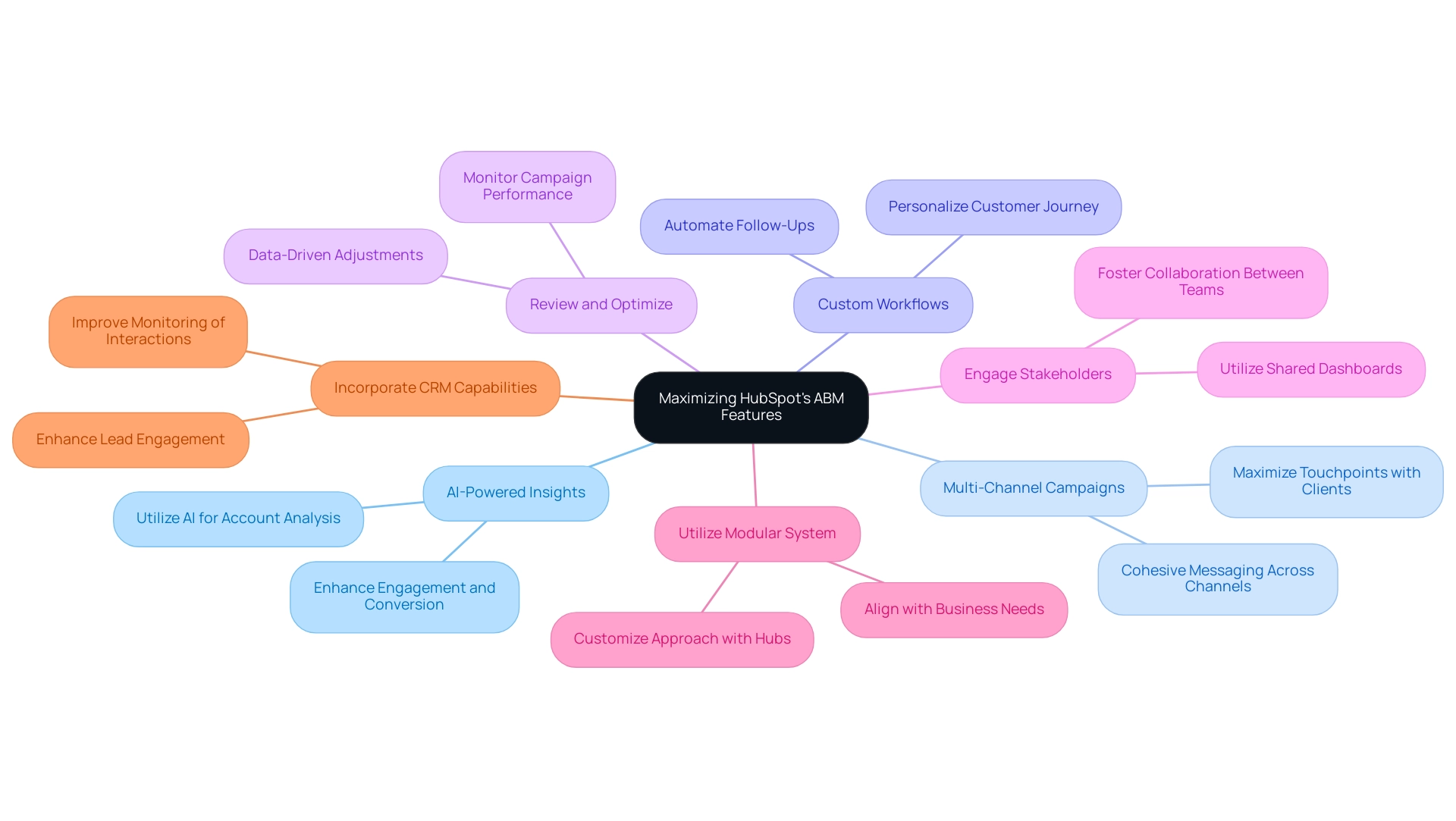
Key Takeaways and Best Practices for Successful ABM with HubSpot
To ensure successful Account-Based Marketing (ABM) with Buldok Marketing and another platform, consider these essential takeaways:
-
Focus on High-Value Accounts: Identify and prioritize accounts that closely match your Ideal Customer Profile (ICP). This targeted approach maximizes ROI and enhances the effectiveness of your promotional efforts.
Leverage Personalization: Utilize the platform's robust tools, such as dynamic content and personalized email campaigns, to craft tailored experiences for each target account. This level of customization significantly boosts engagement, making clients feel valued and understood. However, be mindful of over-personalization, as it can dilute brand identity; balancing personalization with consistent brand messaging is crucial. -
Align Promotion and Sales: Cultivating a strong collaboration between promotion and sales teams is essential. Organizations that achieve tight alignment between these departments have been shown to grow revenues 24% faster and profits 27% faster over three years compared to those with siloed operations.
-
Maximize Efficiency with HubSpot: The account-based marketing HubSpot offers a comprehensive solution for managing all your online promotion from one place. By utilizing its lead generation tools, such as forms and landing pages, along with automation features like workflows and email sequences, you can streamline your promotional efforts and ensure that you engage the right audience effectively.
Measure and Optimize: Continuously monitor performance metrics, such as conversion rates and engagement scores, to assess the effectiveness of your ABM approaches. Use data insights to refine your strategy, ensuring that your tactics evolve in response to what the metrics reveal. -
Stay Informed: The landscape of ABM is ever-changing. Staying informed about the most recent trends and updates in both ABM approaches and related features will enable you to adjust and improve your promotional efforts efficiently. Integrating these best practices can result in substantial advancements in reputation and customer connections, with firms employing ABM noting an 84% increase in reputation and an 80% rise in customer relationships due to effective client service management and communication. As 92% of B2B marketers now consider account-based marketing HubSpot critical to their marketing efforts, implementing these account-based marketing HubSpot strategies can position your organization for success in 2025 and beyond. Furthermore, ABM drives a remarkable 208% boost in marketing-generated revenue, underscoring its effectiveness in achieving business goals.
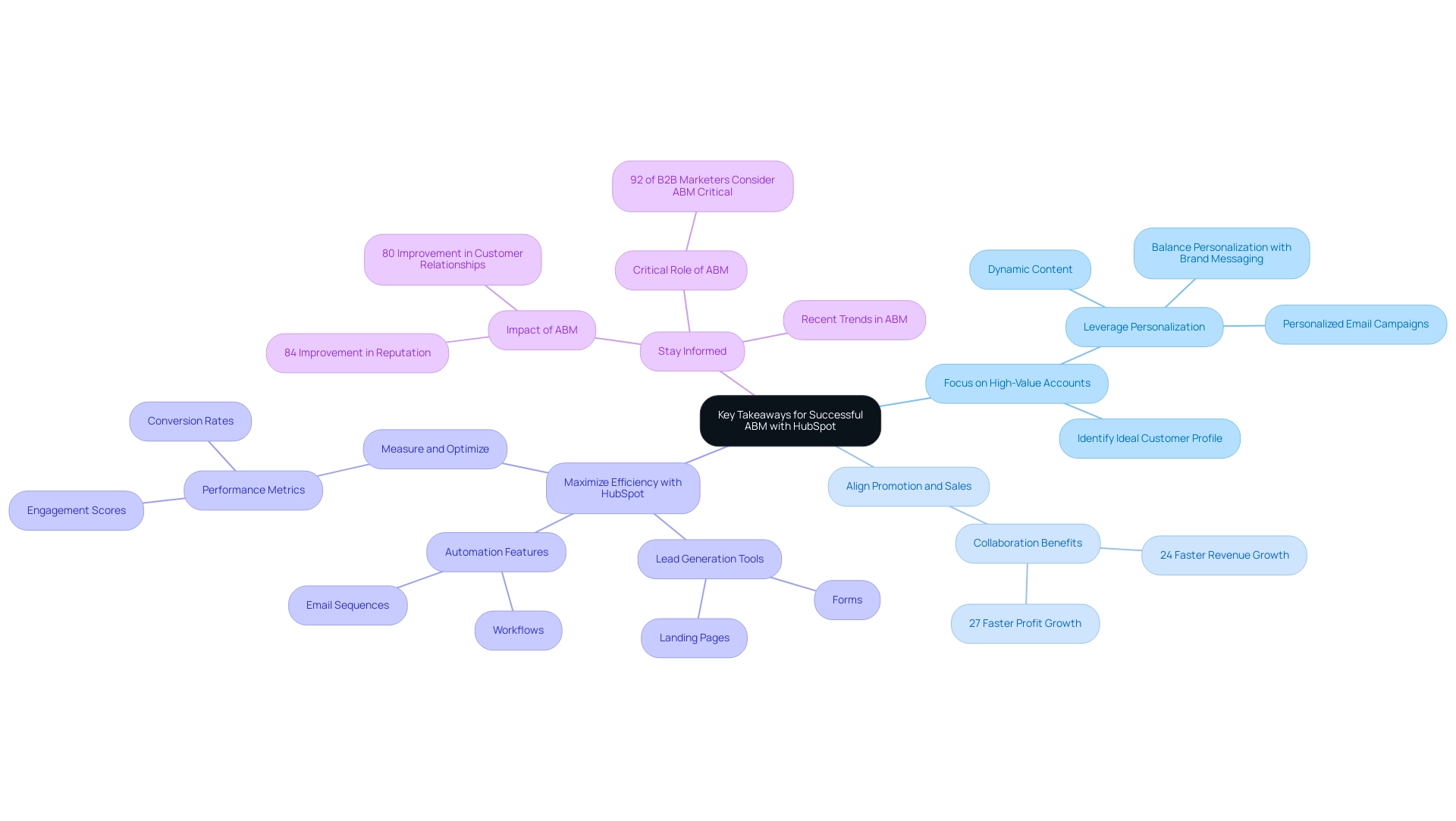
Conclusion
The transformative power of Account-Based Marketing (ABM) is undeniable, especially when integrated with robust platforms like HubSpot. By concentrating on high-value accounts and fostering collaboration between sales and marketing teams, businesses can achieve remarkable growth in revenue and customer engagement. The personalized approach of ABM not only enhances conversion rates but also strengthens relationships with key stakeholders, solidifying its role as a vital strategy for the future.
Utilizing HubSpot’s comprehensive suite of tools enables organizations to streamline their marketing efforts, simplifying the management of campaigns, monitoring engagement, and adjusting strategies based on real-time insights. As companies increasingly adopt ABM, the ability to create targeted, personalized content becomes essential. This approach not only resonates with potential clients but also drives higher retention and satisfaction rates.
In conclusion, implementing ABM strategies through HubSpot can significantly elevate marketing effectiveness, leading to sustainable growth in 2025 and beyond. By prioritizing high-value accounts, embracing personalization, and leveraging data-driven insights, businesses can successfully navigate the complexities of the modern marketing landscape. The future of ABM is bright; those who embrace these practices will be well-positioned to thrive in an increasingly competitive environment.
Frequently Asked Questions
What is account-based marketing (ABM) in the context of HubSpot?
Account-based marketing (ABM) in HubSpot is a focused approach that prioritizes high-value accounts rather than a broad audience, promoting collaboration between sales and promotional teams to drive revenue growth and profits.
How does aligning sales and promotional operations impact revenue and profits?
B2B organizations that align their sales and promotional operations experience revenue growth that is 24% faster and profits that are 27% faster over a three-year period.
What are the benefits of personalized promotional campaigns in ABM?
Personalized promotional campaigns tailored to the unique needs of each account lead to increased conversion rates and enhanced return on investment (ROI).
How can businesses maximize the effectiveness of their ABM strategies?
Businesses can maximize ABM effectiveness by integrating solutions with Buldok Marketing's comprehensive 360° services, which streamline customer journeys and enhance business performance.
What tools does HubSpot provide to support ABM?
HubSpot offers tools like the Marketing Hub for managing online marketing, the Sales Hub for standardizing the sales process, and the Service Hub for ensuring exceptional customer service.
What recent trends indicate the adoption of ABM strategies?
In 2021, 76% of companies expanded their ABM programs, up from 58% in 2020, reflecting a growing recognition of ABM's effectiveness.
What results have companies reported from using ABM strategies?
Companies utilizing ABM strategies report a 90% engagement rate with targeted accounts, a 50% improvement in customer re-engagement through personalized messaging, and enhanced customer retention.
What challenges do marketers face with ABM?
Only 20% of marketers feel equipped with the in-house expertise to manage ABM programs, although there is optimism that advancements in artificial intelligence will help reduce costs and simplify management.
What is the significance of artificial intelligence in ABM?
The incorporation of artificial intelligence within ABM frameworks has been shown to increase revenue for 79% of enterprises, enhancing ABM efficiency.
How can businesses effectively set up an ABM campaign within HubSpot?
To set up an ABM campaign, businesses should define their ideal customer profile, create target account lists, activate ABM tools, develop personalized content, launch their campaign, and monitor and adjust based on analytics.
What role does Buldok Marketing play in enhancing ABM initiatives?
Buldok Marketing complements HubSpot solutions by offering customized approaches and support that enhance the execution of account-based marketing initiatives.




.jpg)